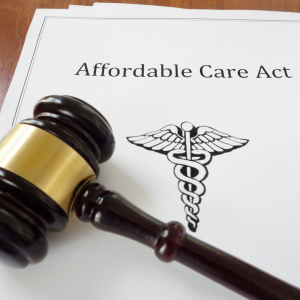
by admin | Feb 26, 2025 | ACA, Custom Content
 At the close of 2024, Congress passed two new pieces of legislation: the Paperwork Burden Reduction Act and the Employer Reporting Improvement Act. These laws simplify the Affordable Care Act (ACA) reporting requirements for employers and introduce new limits on the IRS’s authority to enforce “pay-or-play” penalties, among other changes.
At the close of 2024, Congress passed two new pieces of legislation: the Paperwork Burden Reduction Act and the Employer Reporting Improvement Act. These laws simplify the Affordable Care Act (ACA) reporting requirements for employers and introduce new limits on the IRS’s authority to enforce “pay-or-play” penalties, among other changes.
Under the ACA, applicable large employers (ALEs) and non-ALEs with self-insured health plans must report to the IRS regarding the health plan coverage they offer (or don’t offer) to their employees. Additionally, they must provide individual statements about their health plan coverage.
Previously, ALEs were required to send a health coverage statement (Form 1095-C) to each full-time employee within 30 days of January 31 each year. The IRS allowed non-ALEs with self-insured plans to provide health coverage statements (Forms 1095-B) to covered individuals only upon request. Starting in 2025, ALEs will have the same flexibility as non-ALEs to provide Forms 1095-C upon request.
As a result, employers are no longer obligated to send Forms 1095-C or 1095-B to individuals unless specifically requested. Employers must inform individuals about this option in compliance with any IRS guidelines. Requests for forms must be fulfilled by January 31 of the year following the calendar year to which the return pertains, or within 30 days of the request, whichever is later. These forms may be sent electronically to individuals who have previously consented.
Although the new laws offer reporting flexibility, ALEs and non-ALEs with self-insured plans are still required to submit ACA returns to the IRS. The deadline for electronic filing is March 31, 2025.
Additionally, ALEs may face IRS penalties if they fail to offer affordable minimum essential coverage under the ACA’s employer shared responsibility (pay-or-play) rules. The new legislation extends the time ALEs have to respond to IRS penalty assessment warning letters from 30 days to 90 days. It also establishes a six-year limit on the IRS’s ability to collect penalty assessments.

by admin | Feb 6, 2025 | ACA, Compliance
 For employers subject to the Affordable Care Act (ACA), staying compliant with reporting requirements is non-negotiable. With 2025 due dates just around the corner, now is the time to prepare for distributing Forms 1095-C to employees and filing with the IRS. These forms provide essential information about health coverage offered to employees and are critical for demonstrating compliance with the ACA’s employer mandate. Missing these deadlines can lead to potential costly penalties and compliance headaches.
For employers subject to the Affordable Care Act (ACA), staying compliant with reporting requirements is non-negotiable. With 2025 due dates just around the corner, now is the time to prepare for distributing Forms 1095-C to employees and filing with the IRS. These forms provide essential information about health coverage offered to employees and are critical for demonstrating compliance with the ACA’s employer mandate. Missing these deadlines can lead to potential costly penalties and compliance headaches.
Key ACA Reporting Deadlines for 2025
Here are the critical dates you need to mark on your calendar for reporting on the 2024 tax year:
- March 3, 2025:
Deadline for furnishing Form 1095-C to employees.
Employers must provide their employees with a copy of Form 1095-C, which details the health coverage offered, by this date.
- February 28, 2025:
Deadline for paper filing with the IRS.
Employers filing fewer than 10 forms (aggregated with other forms, such as W-2, 1099) may submit paper forms to the IRS. Note: Paper filing is only an option for small employers below the e-filing threshold.
- March 31, 2025:
Deadline for electronic filing with the IRS.
Employers submitting 10 or more forms are required to file electronically. The extra time provided for electronic filing gives employers a little breathing room, but it’s essential to plan ahead and avoid last-minute delays.
Penalties for Missing ACA Reporting Deadlines
Failing to meet ACA reporting deadlines can result in hefty penalties:
- Late Furnishing to Employees:
Employers can be fined up to $310 per form for not providing Form 1095-C to employees by March 3, 2025.
- Late Filing with the IRS:
Penalties start at $60 per form for filing within 30 days of the deadline but can escalate to $310 per form for longer delays.
- Incorrect or Incomplete Information:
Filing forms with incorrect data, such as employee names or Social Security Numbers, can lead to additional penalties.
- Intentional Disregard:
If the IRS determines that an employer intentionally ignored filing requirements, penalties can skyrocket to $630 per form with no annual cap.
Checklist to Stay on Track for ACA Reporting in 2025
Use this checklist to ensure timely and accurate submissions:
- Verify Employee Data:
Review employee names, SSNs, and coverage details for accuracy.
- Select Your Filing Method:
Determine whether you’ll file on paper (if eligible) or electronically. Ensure you have the necessary software for electronic submissions.
- Monitor Deadlines:
Set reminders for March 3(employee furnishing), February 28 (paper filing), and March 31 (electronic filing).
- Test Your Process:
If filing on your own, conduct a test submission through the IRS AIR system to identify potential errors before the official filing.
- Leverage Technology:
Use an ACA compliance software solution to automate form generation, validation, and submission.
- Train Your Team:
Ensure HR, payroll, and benefits teams understand the reporting requirements and deadlines.
- Work with Experts:
Consider outsourcing ACA compliance to a trusted vendor if your internal resources are limited.
Conclusion
ACA reporting doesn’t have to be overwhelming—preparation is key. By understanding the deadlines, filing methods, and potential pitfalls, employers can stay compliant and avoid penalties. With the reporting season fast approaching, now is the time to finalize your plans, gather your data, and ensure you’re ready to meet the 2025 deadlines.
Originally posted on Mineral

by admin | Oct 29, 2024 | ACA, Compliance
 The Department of Health and Human Services (HHS) has issued a final rule that significantly expands the Mental Health Parity and Addiction Act (MHPAEA) requirements under the Affordable Care Act (ACA). This rule aims to ensure that health plans provide equal coverage for mental health and substance use disorder (MH/SUD) benefits as they do for medical benefits.
The Department of Health and Human Services (HHS) has issued a final rule that significantly expands the Mental Health Parity and Addiction Act (MHPAEA) requirements under the Affordable Care Act (ACA). This rule aims to ensure that health plans provide equal coverage for mental health and substance use disorder (MH/SUD) benefits as they do for medical benefits.
Key Changes in the Final Rule:
Expanded Parity Definition: The rule expands the definition of mental health conditions to include substance use disorders and conditions associated with autism spectrum disorder.
Expanded Treatment Limitations: The rule prohibits health plans from imposing stricter limitations on mental health benefits than those applied to medical benefits. This includes limitations on the number of visits, days of service, or types of treatments.
Enhanced Enforcement: The rule strengthens enforcement mechanisms to ensure compliance with mental health parity requirements.
Implications for Health Plans and Employers
Compliance Review: Health plans will need to review their benefit plans to ensure they comply with the expanded parity requirements.
Benefit Design Changes: Some plans may need to be modified to eliminate discriminatory treatment of mental health benefits.
Increased Costs: The expanded parity requirements may lead to increased costs for health plans.
Improved Access to Care: The rule is expected to improve access to mental health and substance use disorder treatment for individuals with health insurance coverage.
Next Steps for Employers and Employees
Review Your Plan: Employers should review their health plans to ensure compliance with the expanded parity requirements.
Understand Your Benefits: Employees should become familiar with their mental health benefits and how they are covered under their plan.
Seek Assistance: If you have questions or concerns about your mental health benefits, contact your health plan or your employer’s human resources department.
The final rule represents a significant step forward in ensuring that individuals with mental health and substance use disorders have access to the same level of care as those with medical conditions. By understanding the expanded parity requirements, employers and employees can work together to improve access to mental health treatment and promote overall well-being.

by admin | Oct 7, 2024 | ACA, Compliance

by admin | Sep 9, 2024 | ACA, Compliance
 The Affordable Care Act (ACA) introduced the Medical Loss Ratio (MLR) to ensure that health insurance companies spend a significant portion of premiums on medical care and quality improvement activities rather than administrative costs and profits. When insurers fail to meet the MLR threshold, they are required to issue rebates to plan sponsors.
The Affordable Care Act (ACA) introduced the Medical Loss Ratio (MLR) to ensure that health insurance companies spend a significant portion of premiums on medical care and quality improvement activities rather than administrative costs and profits. When insurers fail to meet the MLR threshold, they are required to issue rebates to plan sponsors.
Understanding MLR Rebates
The MLR mandates that health insurers spend at least a certain percentage of premium dollars on medical claims and quality improvement activities. This percentage varies depending on the type of plan. If an insurer’s medical loss ratio falls below the required threshold, they must issue a rebate to the plan sponsor, typically the employer.
Approaching Deadlines: Time to Prepare
It’s essential for employers to be aware of the MLR rebate deadlines. These deadlines vary by year, but typically, insurers have until September 30th of the following year to issue rebates for the previous year’s plan performance. For instance, rebates for 2023 plan performance are due by September 30, 2024.
What to Do with Your MLR Rebate
Employers who receive MLR rebates should carefully consider how to use the funds. While the specific use of the funds depends on the plan’s legal structure and governing documents, some common options include:
- Offsetting future premium costs: Using the rebate to reduce future premium payments.
- Funding wellness programs: Investing in employee wellness initiatives to improve overall health and productivity.
- Contributing to a health savings account (HSA): Offering additional contributions to employee HSAs to help cover healthcare costs.
- Other plan improvements: Using the rebate to enhance other plan benefits or expand coverage options.
Important Considerations:
- ERISA Compliance: If the rebate qualifies as a plan asset under ERISA, it must be used solely for the benefit of plan participants and beneficiaries.
- Documentation: Maintain proper documentation of how the rebate is used to comply with regulatory requirements.
By understanding the MLR rebate process and carefully considering how to use the funds, employers can maximize the benefits of this unexpected windfall and improve the overall health and well-being of their workforce.

by admin | Jul 9, 2024 | ACA, Compliance
 The Patient-Centered Outcomes Research Trust Fund fee, often referred to as the PCORI fee, can be a source of confusion for employers offering health insurance plans. This article aims to simplify what the PCORI fee is, why it exists, and how it impacts your business.
The Patient-Centered Outcomes Research Trust Fund fee, often referred to as the PCORI fee, can be a source of confusion for employers offering health insurance plans. This article aims to simplify what the PCORI fee is, why it exists, and how it impacts your business.
What is the PCORI Fee?
The PCORI fee is an annual charge levied on most health insurance plans and self-funded employer health plans. It was established by the Affordable Care Act (ACA) to fund the Patient-Centered Outcomes Research Institute (PCORI).
What Does PCORI Do?
PCORI is an independent, non-profit organization dedicated to conducting research on the effectiveness of different medical treatments and approaches. Their research helps patients, caregivers, and healthcare providers make more informed decisions about treatment options.
The IRS offers useful resources, including a chart that explains how the fees apply to different types of health coverage and arrangements.
How Much is the PCORI Fee?
The PCORI fee is calculated based on the average number of lives covered under a plan during the policy year. The fee amount is adjusted annually based on inflation in National Health Expenditures. Here’s a quick breakdown:
- For plans ending after September 30, 2023 and before October 1, 2024: The applicable dollar amount is $3.22 per covered life.
- For plans ending after September 30, 2022 and before October 1, 2023: The applicable dollar amount is $3.00 per covered life.
Who Pays the PCORI Fee?
The PCORI fee is generally paid by the issuer of a health insurance plan or the plan sponsor of a self-funded health plan. Employers offering group health plans will typically see the PCORI fee reflected in their health insurance premium statements.
When is the PCORI Fee Due?
The PCORI fee is typically due on July 31st of the year following the last day of the plan year.
Are There Any Exemptions?
Certain types of health plans are exempt from the PCORI fee, including:
- Health Reimbursement Arrangements (HRAs)
- Certain government-funded plans (Medicare, Medicaid)
- Some limited-flexibility plans
The Bottom Line:
The PCORI fee is a relatively small annual cost that helps fund valuable research in patient-centered outcomes. Understanding the purpose and calculation of the PCORI fee can help employers better manage their health insurance expenses and contribute to the advancement of healthcare knowledge.
Additional Resources:
 The Affordable Care Act (ACA) requires large employers to offer affordable health insurance coverage to their full-time employees or face a penalty known as the “Pay or Play” tax. This tax is based on the employer’s average monthly wage (AMW) and the number of full-time employees. The affordability rate for employer-sponsored health coverage will increase from 8.39% to 9.02% of an employee’s household income for the 2025 calendar plan year.
The Affordable Care Act (ACA) requires large employers to offer affordable health insurance coverage to their full-time employees or face a penalty known as the “Pay or Play” tax. This tax is based on the employer’s average monthly wage (AMW) and the number of full-time employees. The affordability rate for employer-sponsored health coverage will increase from 8.39% to 9.02% of an employee’s household income for the 2025 calendar plan year.




